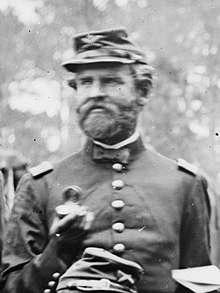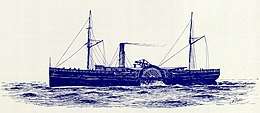Henry Benson (soldier)
Henry Benson (November 20, 1824 – August 11, 1862) was a career United States Army artillery officer who served in the Mexican–American War, Third Seminole War, and American Civil War with the 2nd Regiment of Artillery. He sustained mortal wounds on August 5, 1862 during an engagement at Malvern Hill, and died several days later on August 11 while being transported north aboard the steamer S.R. Spaulding.
Henry Benson | |
|---|---|
 | |
| Born | November 20, 1824 Belleville, New Jersey |
| Died | August 11, 1862 (aged 37) |
| Place of burial | |
| Allegiance | Union |
| Service/ | Union Army |
| Years of service | 1845–1862 |
| Rank | |
| Unit | 2nd U.S. Artillery |
| Commands held | Battery E, 2nd U.S. Artillery Battery M, 2nd U.S. Artillery |
| Battles/wars | Mexican–American War Third Seminole War American Civil War
|
Early life
Henry Benson was born in Belleville, New Jersey. He enlisted in the United States Army on June 6, 1845.[1][2]
He served in the Mexican-American War, where he was breveted for "good qualities" to the rank of second lieutenant on June 28, 1848, later made permanent January 26, 1849.[3][4] He commanded a battery of artillery in the field under General Zachary Taylor, and later General Winfield Scott at the siege of Mexico City.[2] He was promoted to first lieutenant on March 2, 1853.[3][5]
In 1854, Lieutenant Benson was posted in Florida (likely since 1849[6]) during the Army's mission to survey the state and build roads, protect settlers, and relocate the indigenous Seminole tribe—all of which contributed to the Third Seminole War (1855-58).[6][7]
He was heavily involved in the Army's surveying efforts, actively scouting road paths in the field, alternately present at Fort Myers, Fort Meade, Fort Thompson, and Fort Center.[7][8][9][10] Arriving at Fort Center in April 1855, Benson noted his surroundings as "more disagreeable, unhealthy and devoid of interest than I had expected….Mosquitos awful. 1,000,000,000 of them….Hot– hot as fire all day." [11]
In 1856, Benson was commander of the 2nd Artillery, Battery E. On August 2, 1856, that unit engaged the Seminoles at Punta Rassa, an action which concluded the 2nd Regiment of Artillery's duty in Florida. By the end of the year, all units were transferred back north, headquartered at Fort Hamilton, New York.[6][12]
In 1857, Battery E was sent to Kansas to assist in quelling unrest, headquartered at Fort Leavenworth.[6]
In 1860, Battery E was sent to Augusta, Georgia.[6]
Civil War

At the outbreak of the Civil War, Lieutenant Benson was attached to the 2nd Artillery, Battery C, commanded by Brigadier General Lewis G. Arnold, posted at Fort Independence, Massachusetts. In January 1861, Arnold's command was transferred to Fort Jefferson, Florida to aid in the preparation for war following the secession of Florida from the Union.[6][13] Benson was instrumental in assisting with the transfer of heavy artillery from Fort Taylor (under command of Captain John Milton Brannan) to arm Fort Jefferson—described by Arnold as "the key of the Gulf"— under the direction of Captain Montgomery C. Meigs.[13]
In April, 2nd Artillery, Battery M arrived in Florida. It had been sent to Fort Brown, Texas in April 1860 and barely evaded capture by Confederate forces at the outset of the war in April 1861 while fleeing to the Union lines and on to relieve besieged Fort Pickens, Florida.[6][14]
Fellow New Jersian artillerist Lieutenant Julius A. De Lagnel, whose 2nd Lieutenancy Benson succeeded in 1849, defected to the Confederate States in 1861.[6][15]
Benson transferred to Battery M at some point between January and May 1861, as both returned north to join the Virginia campaign in June.[1][6] He was promoted to the rank of Captain on May 14, 1861, replacing Captain Henry J. Hunt of Battery M, who was promoted to Major.[16]
Battery M was engaged at the First Battle of Bull Run in July 1861. Soon after, Battery M commander Major Henry J. Hunt was promoted to colonel as the Chief of Artillery for General George B. McClellan,[17][18] and Benson assumed command of Battery M.[1]
In November 1861, Battery M was converted to a horse artillery battery, equipped with six 3-inch Ordnance rifles.[6]
In 1862 Battery M moved with the Army of the Potomac into Virginia as part of McClellan's Peninsula Campaign (March–July 1862). Benson led his unit effectively through the Siege of Yorktown, the Battle of Hanover Court House, and the Battle of Seven Pines (Fair Oaks Station).[19]
At Seven Pines, Benson's Battery M had a combined total strength on May 31, 1862 of "four officers, 109 noncommissioned officers, mechanics, privates. . . . 141 horses, and six 3-inch rifled guns, with caissons and ammunition complete."[19]
For his service, Captain Benson was reported to be a favorite officer of General McClellan.[4]
Death

After General Robert E. Lee repulsed McClellan's assaults against Richmond, Virginia, what followed was the Seven Days Battles (June 25-July 1, 1862). These battles proved disastrous for the Army of the Potomac, and McClellan refused to take further offensive action from his position at Harrison's Landing without reinforcements. On August 3, 1862, McClellan was ordered by General-in-Chief Henry Halleck to retreat from the peninsula to Aquia Creek and terminate his campaign in order to meet up with the Army of Virginia under General John Pope– an order he only begrudgingly complied with nearly two weeks later.[20]
On August 5, 1862, in a second engagement at Malvern Hill, Virginia (not to be confused with the earlier Battle of Malvern Hill), Benson's battery engaged two regiments of Confederate infantry and an artillery battery in the early hours of the morning. He was mortally wounded during the fire when his leg was broken by the fragment of a burst shell from one of Battery M's guns .[4][21]
Benson was removed to the hospital transport steamship S.R. Spaulding for transport north to medical treatment, but died at sea of his wounds on August 11, 1862. His remains were returned to his hometown of Belleville, New Jersey and buried in the Belleville Dutch Reformed Churchyard on August 13, 1862.[4][22][23]
Legacy
In 1864, an artillery battery in defense of Washington, D.C., was named Battery Henry Benson.[24]
An Endicott Era coast artillery battery at Fort Worden was named after Benson in 1904.[25]
A street in his hometown of Belleville is also named in his honor.[23]
See also
- 2nd U.S. Artillery Regiment
References
- "Battery M, 2nd US Artillery". Crossed Sabers. 2008-09-29. Retrieved 2019-11-10.
- Gregory, V.J. (1976). Keepers at the Gate. Port Townsend, WA: Port Townsend Publishing Co., Inc. p. 119.
- Hamersly, Thomas Holdup Stevens (1888). Complete Army and Navy Register of the United States of America from 1776 to 1887. p. 296.
- "Obituary - Death of Captain Henry Benson, United States Army". The New York Herald. 1862-08-15. p. 5. ISSN 2474-3224. Retrieved 2019-11-10.
- Journal of the Executive Proceedings of the Senate of the United States of America. 1887. p. 55.
- Simpson, W.A. "Second Regiment of Artillery". U.S. Army Center of Military History. pp. 312–327. Retrieved 2019-11-12.
- Stone, Spessard. "Captain Francis Asbury Hendry". Retrieved 2019-11-12.
- Stone, Spessard. "Major General George Lucas Hartsuff". Retrieved 2019-11-11.
- Brown, Canter (1995). Fort Meade, 1849-1900. University of Alabama Press. p. 20. ISBN 978-0-8173-0763-9.
- Seley, Ray B., Jr. (1963). "Lieutenant Hartsuff and the Banana Plants" (PDF). Tequesta. Historical Association of Southern Florida: 5.
- "History of Fisheating Creek". Florida Fish And Wildlife Conservation Commission. Retrieved 2019-11-12.
- Woltjer, Rodger (2018). Military History of the United States (Early Exploration through American Civil War). Hoosick Falls, NY: Merriam Press. p. 161. ISBN 9780359639724.
- Scott, Robert, ed. (1880). The War of the Rebellion: A Compilation of the Official Records of the Union and Confederate Armies. Series 1, Volume 1. Washington, D.C.: Government Printing Office. pp. 345–347.
- Simpson, W.A. "Second Regiment of Artillery". U.S. Army Center of Military History. p. 324. Retrieved 2019-11-20.
- Journal of the Executive Proceedings of the Senate of the United States. 1887. p. 53.
- Diefendorf, Oliver (1864). General Orders of the War Department, Embracing the Years 1861, 1862 & 1863. Derby & Miller. pp. 119.
- Hamersly, Thomas Holdup Stevens (1888). Complete Army and Navy Register of the United States of America, from 1776 to 1887. p. 529.
- U.S. Army Field Artillery School (April 1984). "Right of the Line: A History of the American Field Artillery". Fort Sill, OK. Retrieved 2019-11-10.
- Benson, Henry. ""Reports of Captain Henry Benson" in War of the Rebellion: A Compilation of the Official Records of the Union and Confederate Armies, Series 1, Volume XI". ehistory.osu.edu. pp. 694–696. Retrieved 2019-11-11.
- "Report of Major-Gen. Halleck.; Headquarters of the Army, Washington, 1862". The New York Times. 1862-12-04. ISSN 0362-4331. Retrieved 2020-01-02.
- "A Movement in McClellan's Army". Scientific American. VII. no. 8. Scientific American. 1862-08-11. p. 114.
- "Steamship S.R. Spaulding". Retrieved 2019-11-10.
- "Honoring a long-ago local hero". The Observer Online. Belleville, NJ. 2017-08-09. Retrieved 2019-11-10.
- Townsend, E.D. (1863). “General Order 83” in General Orders of the War Department: Embracing the Years 1861, 1862 & 1863. Washington, D.C.: Derby & Miller. p. 91.
- "Battery Henry Benson". Coast Defense Study Group. Retrieved 2019-11-10.